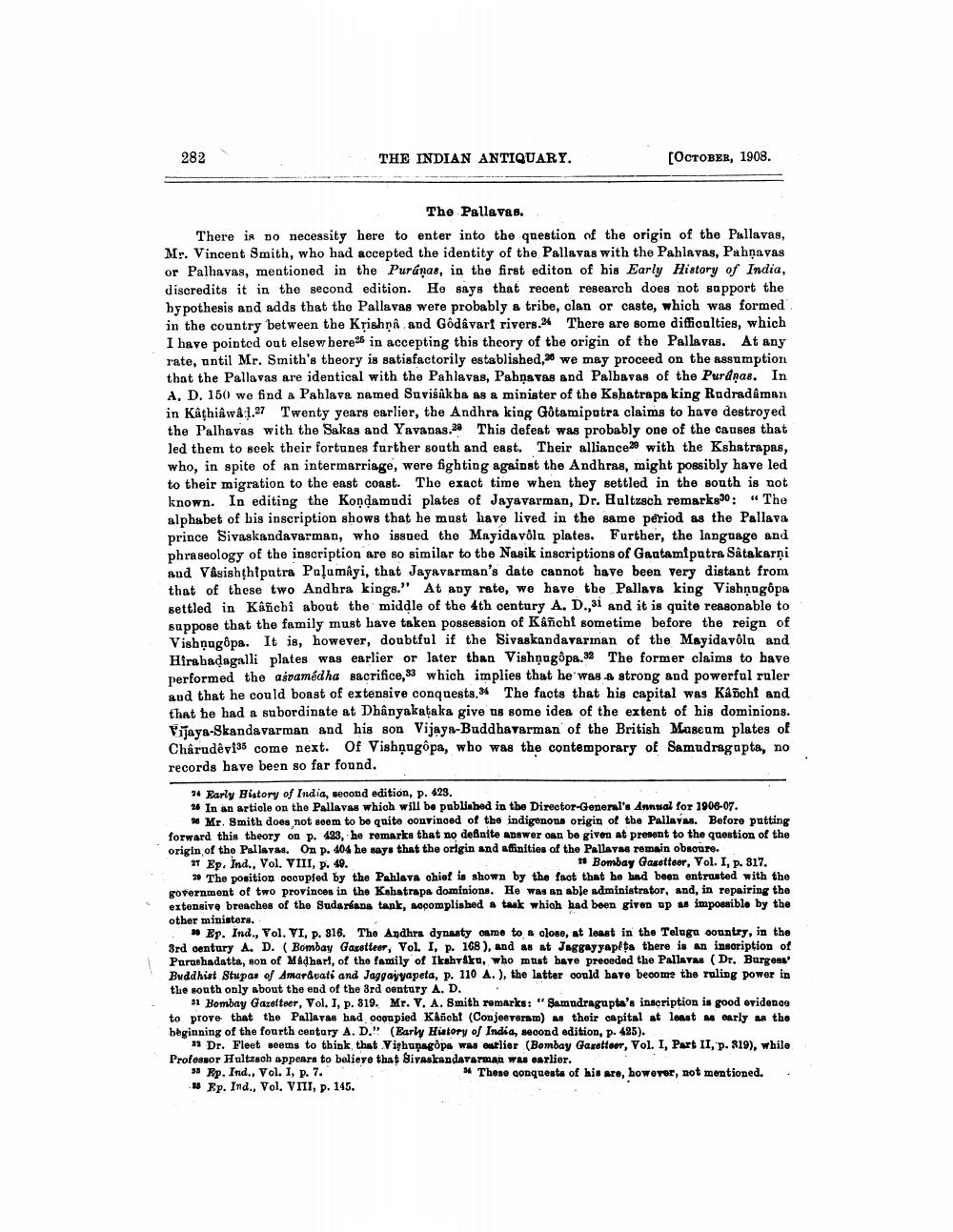________________
282
THE INDIAN ANTIQUARY.
[OCTOBER, 1908.
The Palla vas. There is no necessity here to enter into the question of the origin of the Pallavas, Mr. Vincent Smith, who had accepted the identity of the Pallavas with the Pahlavas, Pahnavas or Palhavas, mentioned in the Puránas, in the first editon of his Early History of India, discredits it in the second edition. He says that recent research does not support the hypothesis and adds that the Pallavas were probably a tribe, clan or caste, which was formed in the country between the Krishna and Gôdåvart rivers. There are some difficulties, which I have pointed out elsewhere in accepting this theory of the origin of the Pallavas. At any rate, antil Mr. Smith's theory is satisfactorily established, we may proceed on the assumption that the Pallavas are identical with the Pahlavas, Pahnavas and Palhavas of the Purdņas. In A, D. 150 we find a Pahlave named Suvisikba as a minister of the Kshatrapa king Rodradâman in Kâthiâwâ:1.27 Twenty years earlier, the Andhra king Götamiputra claims to have destroyed the Palhavas with the Sakas and Yavanas.28 This defeat was probably one of the causes that led them to seek their fortunes further south and east. Their alliance with the Kshatrapas, who, in spite of an intermarriage, were fighting against the Andhras, might possibly have led to their migration to the east coast. The exact time when they settled in the south is not known. In editing the Kondamudi plates of Jayavarman, Dr. Holtzsch remarks90: “The alphabet of bis inscription shows that he must have lived in the same period as the Pallava prince Sivaskandavarman, who issued the Mayidavôla plates. Further, the language and phraseology of the inscription are so similar to the Nasik inscriptions of Gautamiputra Satakarņi and Vâsishthiputra Poļumâyi, that Jayavarman's date cannot have been very distant from that of these two Andhra kings." At any rate, we have the Pallava king Vishṇagopa settled in Kafichi about the middle of the 4th century A. D.,31 and it is quite reasonable to suppose that the family must have taken possession of Káñcht sometime before the reign of Vishnagopa. It is, however, doubtful if the Sivaskandavarman of the Mayidavolu and Hirabadagalli plates was earlier or later than Vishnugpa.32 The former claims to have performed the asvamédha sacrifice, 33 which implies that he was a strong and powerful ruler and that he could boast of extensive conquests. The facts that his capital was Káñcht and that he had a subordinate at Dhânyakataka give us some idea of the extent of his dominions. Vijaya-Skandavarman and his son Vijaya-Buddhavarman of the British Museum plates of Chårudêgi35 come next. Of Vishņugôpa, who was the contemporary of Samudragapta, no records have been so far found.
94 Early History of India, second edition, p. 423. 26 In an article on the Pallavas whioh will be published in the Director-General's Annual for 1906-07.
* Mr. Smith does not seem to be quite convinced of the indigenous origin of the Pallavo. Before putting forward this theory on p. 423, he remarks that no definite answer can be given at present to the question of the origin of the Pallavaa. On p. 404 he says that the origin and affinities of the Pallavas remain obscure. 37 Ep. Ind., Vol. VIII, p. 49.
# Bombay Ganetteer, Vol. I, p. 317. 2 The position oooupled by the Pahlava chief is shown by the fact that he had been entrusted with the government of two provinces in the Kshatrapa dominions. He was an able administrator, and, in repairing the extensive breaches of the Sudariana tank, aopomplished a task whioh had been given up as impossible by the other ministers.
» Ep. Ind., vol. VI, p. 816. The Andhra dynasty came to a close, at least in the Teluga country, in the 3rd oentury A. D. Bombay Gaxetteer, Vol. I, p. 168 ), and as at Jaggayyapeta there is an inscription of Parashadatta, son of Madhart, of the family of Ikshyako, who must have preceded the Pallavas (Dr. Burgess' Buddhist Stupas of Amaravati and Jaggayyapeta, p. 110 A. ), the latter could have become the ruling power in the south only about the end of the 3rd century A. D.
31 Bombay Gazetteer, Vol. 1, p. 319. Mr. V. A. Smith remarks: "Samudragupta's inscription is good evidence to prove that the Pallavas had oooupied Kanchi (Conjeeveram) as their capital at least as early as the beginning of the fourth centary A. D." (Early History of India, second edition, p. 425).
# Dr. Fleet seems to think that Viqhunagopa was outlier (Bombay Gazetteer, vol. I, Part II, p. 819), while Professor Hultzech appears to believe that Sivaskandavarman was earlier. . 33 Rp. Ind., Vol. I, p. 7.
These conquesta of his are, however, not mentioned. . # Ep. Ind., Vol. VIII, p. 145.




